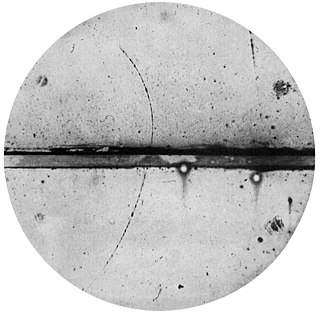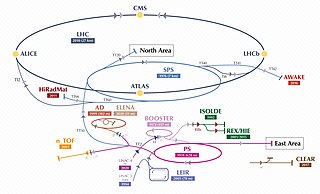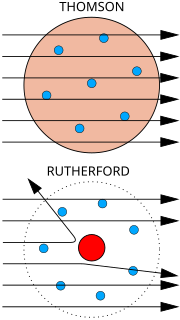
A beam dump, also known as a beam block, a beam stop, or a beam trap, is a device designed to absorb the energy of photons or other particles within an energetic beam. [1]

A beam dump, also known as a beam block, a beam stop, or a beam trap, is a device designed to absorb the energy of photons or other particles within an energetic beam. [1]
Beam blocks are simple optical elements that absorb a beam of light using a material with strong absorption and low reflectance. [1] Materials commonly used for beam blocks include certain types of acrylic paint, carbon nanotubes, anodized aluminum, and nickel-phosphate coatings. [2]
Beam traps are used when it is important that there is no reflectance. Beam traps can incorporate materials used for beam blocks in their design to further reduce the possibility of reflectance. [2]
The purpose of a charged-particle beam dump is to safely absorb a beam of charged particles such as electrons, protons, nuclei, or ions. This is necessary when, for example, a circular particle accelerator has to be shut down. Dealing with the heat deposited can be an issue, since the energies of the beams to be absorbed can run into the megajoules. [3]
An example of a charged-particle beam dump is the one used by CERN for the Super Proton Synchrotron. Currently, the SPS uses a beam dump that consists of graphite, molybdenum, and tungsten surrounded by concrete, marble, and cast-iron shielding. [4]

In modern physics, antimatter is defined as matter composed of the antiparticles of the corresponding particles in "ordinary" matter. Minuscule numbers of antiparticles are generated daily at particle accelerators—total artificial production has been only a few nanograms—and in natural processes like cosmic ray collisions and some types of radioactive decay, but only a tiny fraction of these have successfully been bound together in experiments to form antiatoms. No macroscopic amount of antimatter has ever been assembled due to the extreme cost and difficulty of production and handling.

The Compact Muon Solenoid (CMS) experiment is one of two large general-purpose particle physics detectors built on the Large Hadron Collider (LHC) at CERN in Switzerland and France. The goal of CMS experiment is to investigate a wide range of physics, including the search for the Higgs boson, extra dimensions, and particles that could make up dark matter.

A linear particle accelerator is a type of particle accelerator that accelerates charged subatomic particles or ions to a high speed by subjecting them to a series of oscillating electric potentials along a linear beamline. The principles for such machines were proposed by Gustav Ising in 1924, while the first machine that worked was constructed by Rolf Widerøe in 1928 at the RWTH Aachen University. Linacs have many applications: they generate X-rays and high energy electrons for medicinal purposes in radiation therapy, serve as particle injectors for higher-energy accelerators, and are used directly to achieve the highest kinetic energy for light particles for particle physics.

ATLAS is the largest, general-purpose particle detector experiment at the Large Hadron Collider (LHC), a particle accelerator at CERN in Switzerland. The experiment is designed to take advantage of the unprecedented energy available at the LHC and observe phenomena that involve highly massive particles which were not observable using earlier lower-energy accelerators. ATLAS was one of the two LHC experiments involved in the discovery of the Higgs boson in July 2012. It was also designed to search for evidence of theories of particle physics beyond the Standard Model.

Gargamelle was a heavy liquid bubble chamber detector in operation at CERN between 1970 and 1979. It was designed to detect neutrinos and antineutrinos, which were produced with a beam from the Proton Synchrotron (PS) between 1970 and 1976, before the detector was moved to the Super Proton Synchrotron (SPS). In 1979 an irreparable crack was discovered in the bubble chamber, and the detector was decommissioned. It is currently part of the "Microcosm" exhibition at CERN, open to the public.
A charged particle beam is a spatially localized group of electrically charged particles that have approximately the same position, kinetic energy, and direction. The kinetic energies of the particles are much larger than the energies of particles at ambient temperature. The high energy and directionality of charged particle beams make them useful for many applications in particle physics.

The Super Proton Synchrotron (SPS) is a particle accelerator of the synchrotron type at CERN. It is housed in a circular tunnel, 6.9 kilometres (4.3 mi) in circumference, straddling the border of France and Switzerland near Geneva, Switzerland.

The AWAKE facility at CERN is a proof-of-principle experiment, which investigates wakefield plasma acceleration using a proton bunch as a driver, a world-wide first. It aims to accelerate a low-energy witness bunch of electrons from 15-20 MeV to several GeV over a short distance (10m) by creating a high acceleration gradient of several GV/m. Particle accelerators currently in use, like CERN's LHC, use standard or superconductive RF-cavities for acceleration, but they are limited to an acceleration gradient in the order of 100 MV/m.

ALICE is one of eight detector experiments at the Large Hadron Collider at CERN. The other seven are: ATLAS, CMS, TOTEM, LHCb, LHCf, MoEDAL and FASER.

The Proton Synchrotron is a particle accelerator at CERN. It is CERN's first synchrotron, beginning its operation in 1959. For a brief period the PS was the world's highest energy particle accelerator. It has since served as a pre-accelerator for the Intersecting Storage Rings (ISR) and the Super Proton Synchrotron (SPS), and is currently part of the Large Hadron Collider (LHC) accelerator complex. In addition to protons, PS has accelerated alpha particles, oxygen and sulfur nuclei, electrons, positrons, and antiprotons.

The NA58 experiment, or COMPASS is a 60-metre-long fixed-target experiment at the M2 beam line of the SPS at CERN. The experimental hall is located at the CERN North Area, close to the French village of Prévessin-Moëns. The experiment is a two-staged spectrometer with numerous tracking detectors, particle identification and calorimetry. The physics results are extracted by recording and analysing the final states of the scattering processes. The versatile set-up, the use of different targets and particle beams allow the investigation of various processes. The main physics goals are the investigation of the nucleon spin structure and hadron spectroscopy. The collaboration consists of 220 physicists from 13 different countries, involving 28 universities and research institutes.

The Big European Bubble Chamber (BEBC) is a large detector formerly used to study particle physics at CERN. The chamber body, a stainless-steel vessel, was filled with 35 cubic metres of superheated liquid hydrogen, liquid deuterium, or a neon-hydrogen mixture, whose sensitivity was regulated by means of a movable piston weighing 2 tons. The liquids at typical operation temperatures around 27 K were placed under overpressure of about 5 standard atmospheres (510 kPa). The piston expansion, synchronized with the charged particle beam crossing the chamber volume, caused a rapid pressure drop; in consequence the liquid reached its boiling point. During each expansion, charged particles ionized the atoms of the liquid as they passed through it and the energy deposited by them initiated boiling along their path, leaving trails of tiny bubbles. These tracks were photographed by the five cameras mounted on top of the chamber. The stereo photographs were subsequently scanned and all events finally evaluated by a team of scientists. After each expansion, the pressure was increased again to stop the boiling. The bubble chamber was then ready again for a new cycle of beam exposure.

A particle accelerator is a machine that uses electromagnetic fields to propel charged particles to very high speeds and energies, and to contain them in well-defined beams.

NA61/SHINE is a particle physics experiment at the Super Proton Synchrotron (SPS) at the European Organization for Nuclear Research (CERN). The experiment studies the hadronic final states produced in interactions of various beam particles with a variety of fixed nuclear targets at the SPS energies.

The NA62 experiment is a fixed-target particle physics experiment in the North Area of the SPS accelerator at CERN. The experiment was approved in February 2007. Data taking began in 2015, and the experiment is expected to become the first in the world to probe the decays of the charged kaon with probabilities down to 10−12. The experiment's spokesperson is Cristina Lazzeroni. The collaboration involves 333 individuals from 30 institutions and 13 countries around the world.

The CERN hadron Linacs are linear accelerators that accelerate beams of hadrons from a standstill to be used by the larger circular accelerators at the facility.

The Super Proton–Antiproton Synchrotron was a particle accelerator that operated at CERN from 1981 to 1991. To operate as a proton-antiproton collider the Super Proton Synchrotron (SPS) underwent substantial modifications, altering it from a one beam synchrotron to a two-beam collider. The main experiments at the accelerator were UA1 and UA2, where the W and Z boson were discovered in 1983. Carlo Rubbia and Simon van der Meer received the 1984 Nobel Prize in Physics for their decisive contribution to the SppS-project, which led to the discovery of the W and Z bosons. Other experiments conducted at the SppS were UA4, UA5 and UA8.

The LEP Pre-Injector (LPI) was the initial source that provided electrons and positrons to CERN's accelerator complex for the Large Electron–Positron Collider (LEP) from 1989 until 2000.

FASER is planned to be one of the eight particle physics experiments in 2022 at the Large Hadron Collider at CERN. It is designed to both search for new light and weakly coupled elementary particles, and to study the interactions of high-energy neutrinos.

A fixed-target experiment in particle physics is an experiment in which a beam of accelerated particles is collided with a stationary target. The moving beam consists of charged particles such as electrons or protons and is accelerated to relativistic speed. The fixed target can be a solid block or a liquid or a gaseous medium. These experiments are distinct from the collider-type experiments in which two moving particle beams are accelerated and collided. The famous Rutherford gold foil experiment, performed between 1908 and 1913, was one of the first fixed-target experiments, in which the alpha particles were targeted at a thin gold foil.